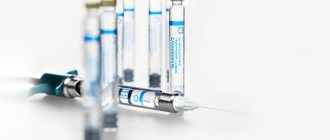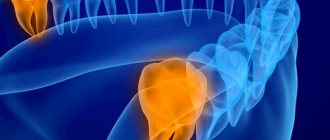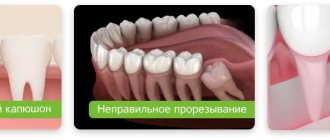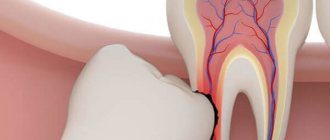Tooth extraction is a dental surgery. Prescribed in case of impossibility of using or ineffectiveness of tooth-preserving treatment. The operation consists of extracting the roots of damaged teeth or a diseased segment from the socket using special instruments.
When it comes to pulling out, any person has associations with severe pain and blood. Unfortunately, just 10 - 15 years ago, tearing out problem units was accompanied by exactly these symptoms. Modern technologies and instruments make it possible to carry out this procedure without pain, fear and tears. The Center for Professional Dentistry near the Otradnoye metro station provides painless and atraumatic extraction of teeth to patients who have indications for this operation.
Contraindications for surgery:
- I, III trimester of pregnancy;
- days of menstruation (due to decreased blood clotting);
- taking anticoagulants;
- hemostasis disorders;
- severe somatic diseases;
- oral infections;
- acute respiratory diseases.
In what cases is removal necessary?
Invasive intervention can be carried out urgently (it is necessary to urgently provide assistance to the patient) and routinely. In what cases is a tooth removed (indications for manipulation):
| Planned operations | Emergency indications |
| Destruction of the crown in which it is impossible to save the unit | Acute purulent inflammation complicated by periostitis, odontogenic osteomyelitis |
| Supernumerary segment or its retention in the jaw (retention) | Exacerbation of chronic inflammation in periodontal tissues |
| Atypical position of wisdom teeth | Abscess |
| High mobility of units in periodontitis | Phlegmon |
| Cyst, granuloma of the apical zone | Lymphadenitis |
| Removal of the root element (six or seventh), if it interferes with orthopedic, orthodontic treatment, implantation | Jaw injury |
| Extraction of the milk element (prevents the eruption of the permanent segment) | |
| Tumors of the jaw |
Indications for tooth extraction
In dental practice, there are few cases when tooth extraction rather than treatment is recommended. These include:
- diseases and exacerbation of diseases of the teeth and gums - such as sinusitis of the maxillary sinuses, purulent periostitis
- cases when wisdom teeth interfere with normal life, eating - they scratch the inner surface of the cheeks or damage nearby teeth
- swelling and fracture of the jaw - in this situation, teeth located next to the treatment area are removed
- teeth due to which the entire dentition is deformed - this often occurs with malocclusion
- if the tooth cannot be replaced or restored
- cases when a tooth interferes with the installation of crowns or other types of prosthetics
That is, tooth extraction is recommended only in particularly difficult cases, when its presence can cause harm to health or other healthy teeth, interfere with treatment, or cause insufficient treatment of the disease.
It is also worth knowing that there are cases when tooth extraction is not recommended. These include tooth extraction during exacerbation of chronic heart and mental diseases, acute infectious diseases and pregnancy at certain stages. In this case, you will have to wait until the end of treatment or the time suitable for tooth extraction.
What is the removal procedure like?
Before planned removal, the patient must undergo preparation for the event:
- Clinical and x-ray examination (clarification of the diagnosis, resolving the issue of the need for extraction, studying the structure of the segment).
- Clinical and laboratory examination.
- Consultation with narrow specialists in the presence of somatic pathologies (in the clinic at the place of residence).
- Sanitation of carious cavities.
- Removal of supragingival and subgingival dental plaque.
Consequences of deletion
After removing the nerve of the tooth, the dentist can place an implant. Its implantation is carried out to prevent displacements and changes in the bite. It is better not to postpone this event.
After surgery, you need to take some measures to promote recovery. You should refrain from eating hot food for the next 4 hours, from cleaning, and from frequent rinsing. If noticeable swelling occurs, your temperature rises, or your breath begins to smell bad, you should visit your dentist.
You can have a tooth removed painlessly at the Dental Clinic "Dentist's Practice". Our doctors constantly improve their skills and participate in specialized seminars and conferences in Russia and abroad. We use the latest equipment and certified materials. In our clinic in Moscow, doctors use modern anesthetics and perform tooth extraction in the most comfortable manner for the patient. After extraction, the gums recover within a week. If necessary, the doctor may prescribe general anesthesia for severe pain, swelling, or high fever. Together with the anesthesiologist, the dentist carefully selects the type of anesthesia, taking into account the patient's characteristics.
We use safe medications that meet international standards and choose proven drugs. After surgery and treatment, our dentists consult patients and conduct follow-up appointments.
Models of forceps for tooth extraction
To pull out a specific tooth, you need to use a specific model of forceps:
| Unit location | Purpose and types of forceps |
| Canine, maxillary incisor | For the anterior segment, forceps with narrowed cheeks and straight ones are used. |
| Maxillary premolars | S-shaped forceps with wide cheeks are used to extract the first or second chewing segment |
| First, second molars from above | There are two types of such a tool: for the right and left sides. On one of the cheeks there is a spike-like protrusion, on the other there is a groove with a rounded tip. |
| Third molars | To remove wisdom teeth, use bayonet-shaped pliers. The cheeks are identical, wide, and have a concave groove. |
| Lower incisors | For the lower front elements, a beak-shaped tool with a narrow working surface is used. |
| Canines, premolars of the lower jaw | Wide beak-shaped forceps with grooves. |
| Removing a root or its fragment (top) | Forceps with thin narrow cheeks (when closed, their ends touch) |
| Molars from below | S-shaped, with a spike on one side, the second surface is rounded. |
| Lower third molars | Flat tweezers. |
Indications: when removal is necessary
Teeth have to be removed due to infections in the mouth that destroy the teeth. It is important to identify and treat such diseases in a timely manner. When therapy does not solve the problem, the tooth has to be removed.
Indications for the procedure:
- inflammation in the mouth
- root fracture,
- destruction of roots,
- gum injury,
- the need to make an arch on the jaw.
Tooth extraction is indicated for patients with periodontitis, cysts, and advanced caries. To prevent the problem, you should carefully maintain dental hygiene. The following also lead to extraction: its fractures, loosening.
Removal methods
Depending on the location of the affected unit and the complexity of the clinical case (last units in a row, significant destruction of the crown, retention, dystopia), removal can be carried out according to two different protocols: simple and complex. The first operation lasts about a quarter of an hour, complex extraction - approximately half an hour. Operation scheme:
- Anesthesia (local, general).
- Treating the oral cavity with an antiseptic.
- Separation of the circular ligament from the neck of the tooth with a scalpel or smoother.
- Simple method. Forceps are applied to the diseased segment and dislocated. The unit is removed from the alveoli.
- For difficult removal. The gum is cut with a scalpel. The crown is split into pieces (with a chisel or drill), which are then pulled out of the hole one by one. The root is separated from the gum with a periotome and removed with an extractor (or forceps). The wound is sutured.
- Inspection of the hole using a curettage spoon.
- Medical tamponade of the wound opening.
Wisdom tooth removal
A wisdom tooth can be removed only according to the following indications:
- cystic formation in the apical zone;
- dystopia;
- carious destruction;
- the appearance of a gingival hood;
- impaired eruption (pericoronitis);
- cause problems with bite;
- previous orthodontic treatment.
Removal of front teeth
Extraction of segments of the smile zone is carried out for medical and aesthetic reasons:
- purulent periodontitis;
- crown fracture exposing the pulp;
- severe destruction of the supragingival part of the segment without the possibility of its use as a support for the crown;
- complete, partial retention;
- extreme degree of mobility in severe periodontitis;
- jaw injury (if the segment is located in the fracture gap);
- a supernumerary element that disrupts diction and interferes with chewing food.
Removal of impacted and dystopic teeth
The retention of a segment in the jaw or alveolar process is called retention. Dystopia is an abnormal eruption of a unit. Both pathologies disrupt the bite and negatively affect speech, chewing, and swallowing.
Impacted and dystopic segments can damage neighboring teeth and disrupt the functioning of the temporomandibular joint. They often cause inflammation, accompanied by pain and swelling of the gums. Before removing such units, an x-ray examination is performed. Based on its results, the issue of the need for extraction is decided.
Originally from the USSR™ – complex tooth extraction with a chisel!
A chisel is a tool from the times of the USSR, when there were no drills in surgical rooms for drilling bone tissue and sawing roots. The way teeth are removed with a chisel is more like a horror movie, when the doctor places the sharp end of the chisel on the bone tissue next to the tooth, while the nurse hits the chisel with a wooden hammer over and over again. Removing a tooth with a chisel is very traumatic for the bone tissue of the jaw and the temporomandibular joint, and often leads to complications.
Often the chisel slips off the bone and penetrates deeply into the soft tissues of the floor of the mouth; the chisel can also easily perforate the maxillary sinus of the upper jaw. Very often, the use of a chisel leads to injury to the mandibular nerve, which runs just under the tips of the roots of the lower teeth. Such an injury can lead to both the development of neuritis and prolonged pain, as well as prolonged numbness of part of the face. The use of a chisel is not permitted.
Anesthesia (narcosis) during removal
Tooth extraction is carried out mainly under local anesthesia. General anesthesia is performed if there are indications:
- it is necessary to extract a wisdom tooth with curved or fused roots;
- the patient has a history of allergies to local anesthetic drugs;
- mental illness;
- excessively developed vomiting syndrome;
- simultaneous extraction of several units;
- difficult removal;
- panic fear.
Anesthesia is administered by an anesthesiologist. It is carried out by inhalation or parenterally.
Local anesthesia is the administration of anesthetics (conduction, periodontal, intraosseous) in order to lose sensitivity of the diseased segment and periodontal tissues. The effect of local anesthesia does not last long.
Sedation in dentistry is the process of putting a patient into a state of comfort. The method allows you to eliminate fear and relax. During sedation, the person is conscious and can answer the doctor’s questions. Sedatives are not a substitute for anesthesia.
How is tooth extraction performed?
Tooth extraction is usually performed under local anesthesia, but if you are intolerant to all known anesthetics or have high anxiety, you can perform tooth extraction under general anesthesia. The use of modern anesthetics with vasoconstrictors (for example, Ultracaine) guarantees a completely painless procedure, but provided that the patient does not abuse analgesics, alcohol or drugs.
In some cases, patients still complain of pain during the procedure, which most often occurs either with significant acute purulent inflammation or with the removal of lower molars (6-7-8 teeth). In both cases, the pain occurs more due to the fault of the doctor, because speaks of insufficient skills in administering conduction anesthesia. Let's give an example. In the upper jaw, the bone tissue is very porous, and therefore the injection of an anesthetic there is usually done into the gum - right in the projection of the tooth root. In dentistry, such anesthesia is called “infiltration”.
But when removing teeth on the lower jaw (primarily 6-7-8 molars), it makes no sense to inject an anesthetic near these teeth, because The bone in this area is very dense, and therefore the anesthetic simply will not penetrate to the roots of the tooth. To anesthetize large molars of the lower jaw, a more complex technique called “conduction anesthesia” is used. The injection is made in the area of the inner surface of the lower jaw branch, because It is in this place that the so-called inferior alveolar nerve passes, which provides pain sensitivity to the lower teeth on this side.
Infiltration and conduction anesthesia (video 1-2) –
The effect of infiltration anesthesia on the upper jaw occurs within a few minutes and lasts (depending on the type of local anesthetic) from 15 to 45 minutes. In this case, the onset of anesthesia is signaled to us by the appearance of numbness in the cheek or upper lip. The effect of conduction anesthesia on the lower jaw occurs within 5-10 minutes, but it can last up to several hours. In this case, the following symptoms tell us about the onset of anesthesia - there must be pronounced numbness in half of the lower lip, as well as the tip of the tongue.
Important: if the numbness of half the lip is weak or absent, it means the doctor missed and was unable to remove the anesthetic near the inferior alveolar nerve. And here you must either ask the doctor to repeat the anesthesia, or you will have to endure the pain. After numbness sets in, we proceed directly to tooth extraction, and depending on the complexity of the tooth, removal can be simple or complex. Because technically, these removal options are very different from each other - we will describe them separately from each other.
What complications can there be?
Serious complications after removal are rare (dislocation, fracture of the lower jaw, damage to adjacent teeth, gum rupture). They can only occur due to unprofessional actions of the surgeon.
In addition, the following conditions are possible:
- Bleeding from the wound. Associated with capillary damage, hemostasis disorders, etc.
- Alveolitis (alveolitis). Often occurs when the doctor’s recommendations are not followed during the recovery period.
- “Dry alveolus” is the absence of a blood clot in the socket.
- Trigeminal neuritis.
- Impaired sensitivity of certain areas of the mouth or head.
Complications are usually accompanied by pain, swelling, hyperthermia, and other symptoms. If they occur, you should consult a doctor.
What you need to know before surgery
Before surgery, you need to find out what is paid and what is free under compulsory medical insurance. It is important to know that you will have to pay extra for some related services, for example, for anesthesia, consumables, and x-ray film. As a rule, this is a small amount, but you need to take the money with you for the operation.
Important! All medications included in the vital list are provided free of charge. These are lidocaine, novocaine, arsenic and arsenic-free drugs. Also included in the free list are consumables (bandages, cotton wool, syringes) and filling materials.
It is necessary to ask your doctor in advance about possible risks and complications after wisdom tooth removal. Negative consequences include increased body temperature, swelling of the gums, the appearance of a cyst, bruises on the cheek, and pain when opening the jaw. The most dangerous complication that requires emergency medical attention is severe bleeding.
Related article: Compulsory medical insurance points on the map
All services included in the compulsory medical insurance program must be provided free of charge. If they demand money from a patient, then you need to call the insurance company. The Investigative Committee representative will tell you what to do in this case and who to complain to. It is necessary to defend your right to receive free dental care, since the patient is not treated for free, the state pays for it.
Rules for caring for the oral cavity after tooth extraction
To avoid adverse consequences, a number of rules must be followed after surgery:
- the first meal is possible after 2.5 - 3.5 hours;
- Do not touch the wound or the resulting clot;
- do not rinse your mouth;
- chew food on the opposite side;
- It is recommended that on the day of intervention, apply a cold compress to the sore side of the cheek for 15 minutes every 3 to 4 hours;
- You cannot drink alcohol, smoke, go to the sauna, or sunbathe.
Take medications prescribed by the surgeon. Visit the dentist for a checkup.
The procedure for providing dental care under compulsory medical insurance
To treat teeth for free in non-profit dental clinics, you need to present your passport, SNILS and compulsory medical insurance policy at the reception.
To make an appointment with a dentist you must:
- Join the clinic. To do this, you will need the same passport, compulsory medical insurance and SNILS. The patient's outpatient card will be kept at the reception desk.
- Take a voucher to see a doctor. You can make an appointment with a dentist at the reception desk, by phone, through the government services portal, or through the website of a medical organization.
- Visit a dentist. You can only see a surgeon by referral. First, the examination is carried out by a dentist. If there are indications for wisdom tooth removal, the patient is referred for surgery.
Reviews from our patients
Irina Sergeevna:
I had a molar removed a month ago. I would like to thank the staff for their attentive attitude and professionalism. The operation was performed under local anesthesia. I didn't feel any pain at all. The tooth extraction took place without negative consequences and the price was quite satisfactory.
Anatoly:
I'm getting ready for implantation. I had to remove 2 teeth. After the operation, my jaw hurt a little. Everything is fine now. Today I came for a follow-up examination, there were no complications.
How to remove a tooth if implantation is planned -
If you are planning to install a dental implant in place of an extracted tooth, then under no circumstances should you first remove the tooth and then only go to an implantologist for a consultation - otherwise, along with the implant, you will then have to spend money on bone grafting. A tooth should only be removed by an implantologist, and this should be done as atraumatically as possible for the bone tissue, and bone material should be placed in the hole itself, covered with a membrane, and the hole should be sutured tightly.
And then after 3 months you will receive excellent bone for tooth implantation, and will not need bone grafting. In addition, there are models of implants that can be installed in the socket of an extracted tooth (immediately after its extraction) - this is the so-called immediate implantation technique. At the link below you can see the online implantation calculator we have developed. By selecting missing teeth and the implant option, you will immediately see the average cost of installing implants in your case.
→ ONLINE IMPLANTATION COST CALCULATOR »»»
Questions and answers
Is there an appointment with the surgeon? To make an appointment with a surgeon, contact the reception desk in person or call. In addition, if you live in Moscow, you can leave a request on the website in the “Teeth Removal” section
Where to remove a tooth? How to find your clinic? North-Eastern Dental Center No. 1 is located near the Otradnoye metro station, at the address: Moscow, st. Pestelya, no. 6.
Is it possible to have a tooth pulled out during pregnancy? Removal is a surgical operation performed using anesthesia. In addition, manipulation is a stress factor for the body. Therefore, extraction of the diseased segment during this period is only indicated.
I have caries in my back seven. How much does it cost to extract a tooth under general anesthesia? The cost depends on the complexity of the operation. The preliminary amount to be paid will be announced by the doctor at the initial consultation.
Does it hurt to have teeth removed? Modern methods and medications allow atraumatic tooth extraction without pain!
Tooth extraction: price in Moscow
How much does it cost to pull out a tooth? The price will primarily depend on the complexity of the removal. However, keep in mind that the cost of tooth extraction will also be affected by the price category of the clinic (where you go). In economy class clinics, the price can be 2-3 times lower compared to clinics of a higher price category. But if you want to have a tooth removed very inexpensively, the price will be lower in a paid department of a state dental clinic.
It is also worth remembering that if you have a medical insurance policy and a passport, then at your place of residence you can have your teeth removed for free (if we are talking about removing a decayed tooth or due to acute pain). But removal in the direction of an orthodontist or prosthetist in a paid department will be paid even in a public clinic, even if you have a policy. The prices below are for 2021.
How much does it cost to remove a tooth in an economy class clinic –
- Simple tooth extraction – 1,500 rubles. The price already includes anesthesia, but if you need to put a stitch, you will probably be charged another 300-500 rubles.
- Tooth extraction of medium complexity – 3000 rubles. This cost already includes anesthesia, stitches, and sometimes a re-examination.
- Complex tooth extraction – about 5,000 rubles. It is usually carried out by drilling out the bone and making an incision in the gum. This category also includes the removal of complex eighth teeth. The stated price includes anesthesia, stitches and, as a rule, repeated examinations.
How much does it cost to pull a tooth: price in clinics of medium and high price categories
- Simple removal – 3500 rub. This price already includes “all inclusive” (anesthesia, stitches, re-examination).
- Complex removal - from 7500 to 9500 rubles. those. with making an incision, sawing out the bone, and also includes the removal of complex eighth teeth. This price is also “all inclusive”.
Important: in most cases it is very difficult for the patient to predict the complexity of future removal. But there are guidelines. For example, all single-rooted teeth are usually removed very easily, even if it is necessary to remove a completely destroyed tooth. More often, removal is difficult when removing multi-rooted 6-7-8 upper and lower teeth.











